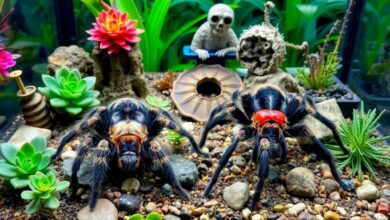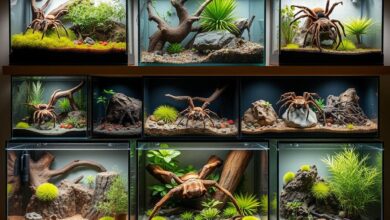How to Clean and Maintain Your Tarantula’s Habitat
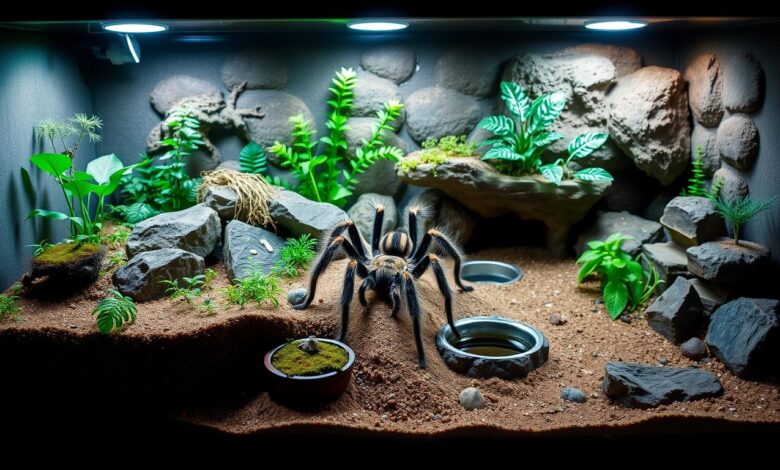
It’s very important to keep your tarantula’s habitat clean and healthy. This guide will teach you how to clean and care for your tarantula’s terrarium. This way, you’ll create a safe and perfect place for your arachnid pet.
We’ll teach you how to use the best cleaning supplies. You’ll also learn how to care for the substrate and decorations. We’ll talk about how to control humidity and ventilation, and how to adjust lighting.
We’ll give you tips on how to avoid pests and the most recommended tools. We’ll also tell you when it’s time to do a deep cleaning. We’ll show you how to safely move your tarantula during cleaning.
Find out how to keep your tarantula’s habitat always clean and healthy. Read on for more information.
Introduction to Tarantula Habitats
Tarantulas need specific tarantula habitat requirements and environmental needs to stay healthy. Knowing these needs is key to setting up a good tarantula enclosure and housing considerations for your pet.
Understanding Tarantula Needs
Tarantulas are very sensitive to their environment. They need the right temperature, humidity, substrate, and hiding spots. Getting these elements right is vital for a suitable living space for your tarantula.
Importance of Proper Housing
Choosing the right tarantula housing is essential for your pet’s health and safety. A well-designed enclosure meets their environmental needs and makes care easier. Setting up a good tarantula enclosure improves your pet’s life a lot.
| Key Tarantula Habitat Requirements | Ideal Conditions |
|---|---|
| Temperature | 75-85°F (24-29°C) |
| Humidity | 60-80% |
| Substrate | Potting soil, coconut fiber, or a mix |
| Hiding Spots | Cork bark, rocks, or hide boxes |
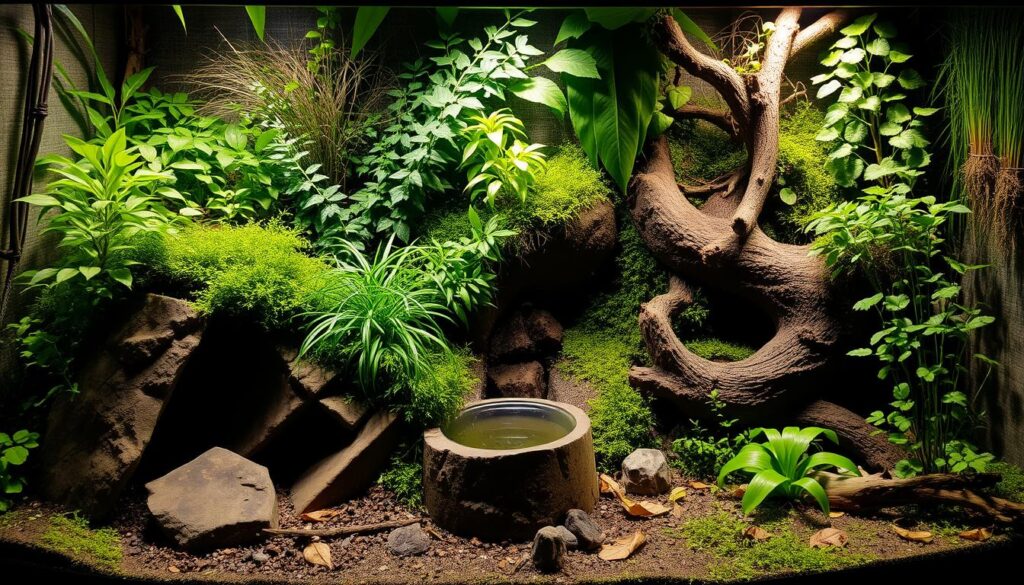
By understanding and meeting the tarantula habitat requirements and tarantula environmental needs, you can create a great home for your tarantula. Investing in the right proper tarantula enclosure setup and housing considerations is the first step to a rewarding tarantula ownership experience.
Terrarium Cleaning Supplies
Keeping your tarantula’s home clean is key to their health. You’ll need the right tools to clean and care for their terrarium. These items will help keep their space clean and safe.
Start by getting a good substrate to replace the old one. Choose substrates like coco fiber, peat moss, or a mix of both. They offer the right moisture and drainage for your tarantula.
- Coco Fiber Substrate
- Peat Moss
- Substrate Mixing Tools
You’ll also need decorations and hiding spots for your tarantula. Use natural branches, rocks, or live plants. Make sure you have cleaning tools for these items too.
- Natural Branches
- Decorative Rocks
- Terrarium-Safe Plants
- Cleaning Brushes
- Disinfecting Spray
Don’t forget to keep your tarantula’s water dish clean. You’ll need a dedicated dish and cleaning tools for it.
| Item | Price | Shipping Cost | Location | Delivery Time | Return Policy | Payment Options | Item Number |
|---|---|---|---|---|---|---|---|
| Tarantula Water Dish | $7.50 | $6.70 | Charleston, West Virginia, United States | Between Wed, Sep 25 and Fri, Sep 27 to 08854 | 30 days returns, with the buyer paying for return shipping | Special financing available | 266949954066 |
With these terrarium cleaning supplies, tarantula habitat cleaning tools, and items for terrarium maintenance, you’re ready. Your tarantula’s home will stay clean and healthy.
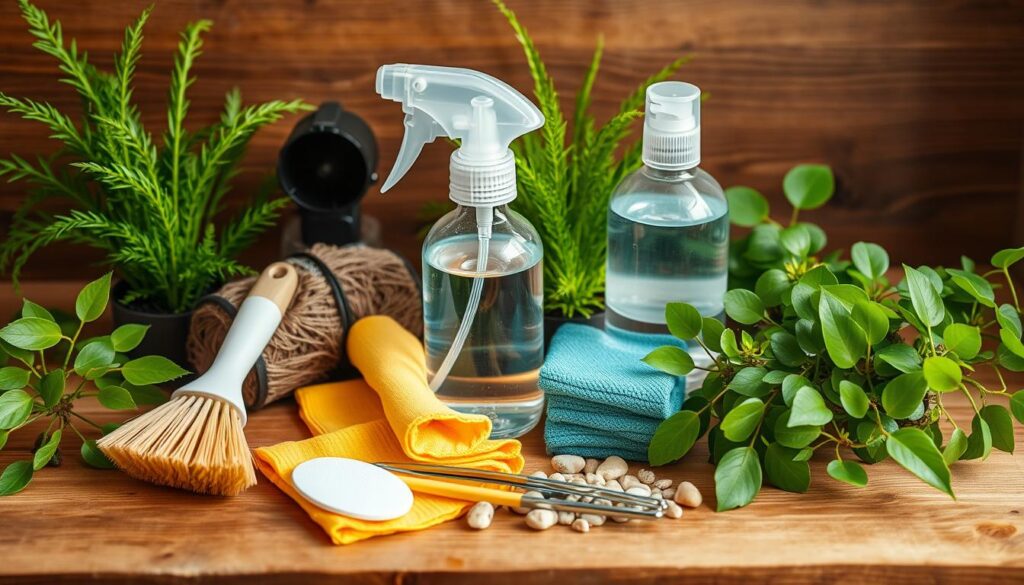
Cleaning and maintaining the terrarium
Keeping your tarantula’s home clean is key for its health. This means taking care of the terrarium substrate and any decorations or plants. It’s all about creating a clean and natural space for your pet.
Substrate Maintenance Routine
The terrarium’s substrate mix is made of different parts. It has a base, structural materials, and compost. A good mix includes orchid bark, earthworm castings, coco coir, and horticultural charcoal. This mix helps with water and keeps the terrarium dry.
 The best substrates for the tarantula terrarium
The best substrates for the tarantula terrarium
Check the substrate often for dirt or compaction. Clean any dirty spots right away. Every 2-3 months, take out the old substrate and put in new, moist mix.
Decorations and Plants Care
It’s just as important to keep the terrarium decor and plants clean and healthy. Make sure artificial decorations are clean and won’t fall over. Live plants need misting and trimming to stay healthy.
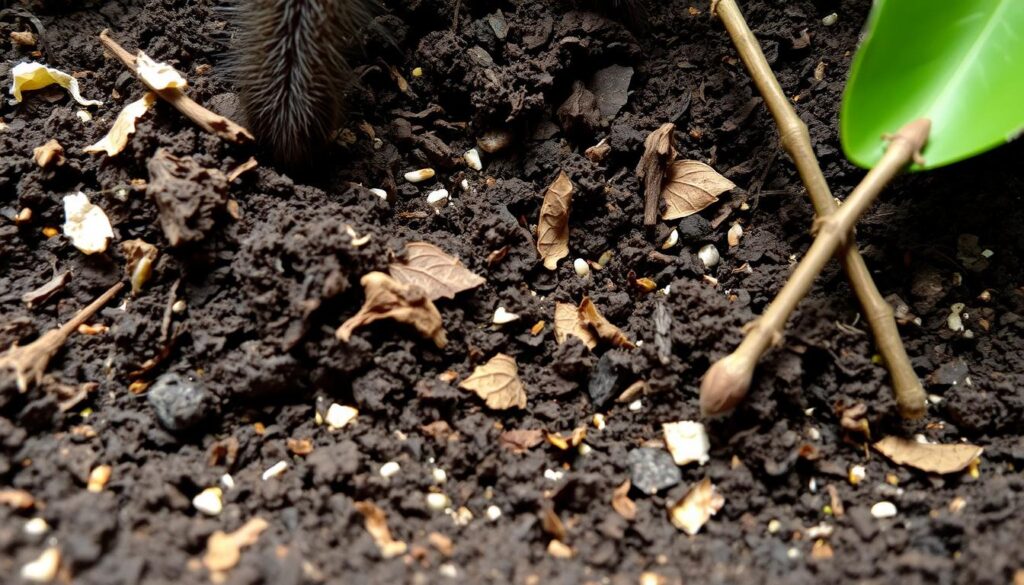
If you have live moss, keep it moist for the first 3-4 weeks. This helps it settle in well. You can use superglue or fishing line to attach moss to terrarium parts.
Humidity and Ventilation Control
Keeping the right humidity and air flow in your tarantula’s home is key for its health. Tarantulas need specific conditions to live well. Finding the perfect balance between moisture and air can be tricky.
To keep the right humidity, use a good hygrometer to check the moisture. Most tarantulas like a humidity of 60% to 80%. You can keep the humidity up by misting the substrate or adding a water dish.
Good air flow is also vital to stop mold and keep air fresh. Your terrarium needs enough air to let in new air. You can add mesh panels, vents, or small holes to help air move. But, don’t seal the terrarium too much, as it can cause too much moisture and bad air flow.
| Terrarium Type | Ideal Humidity Range | Ventilation Requirements |
|---|---|---|
| Desert Terrarium | 40% – 60% | Moderate to High Airflow |
| Tropical Terrarium | 70% – 90% | High Airflow |
| Temperate Terrarium | 50% – 70% | Moderate Airflow |
By watching and adjusting the humidity and air flow, you can make a great home for your tarantula. This will help it stay healthy and happy for a long time.
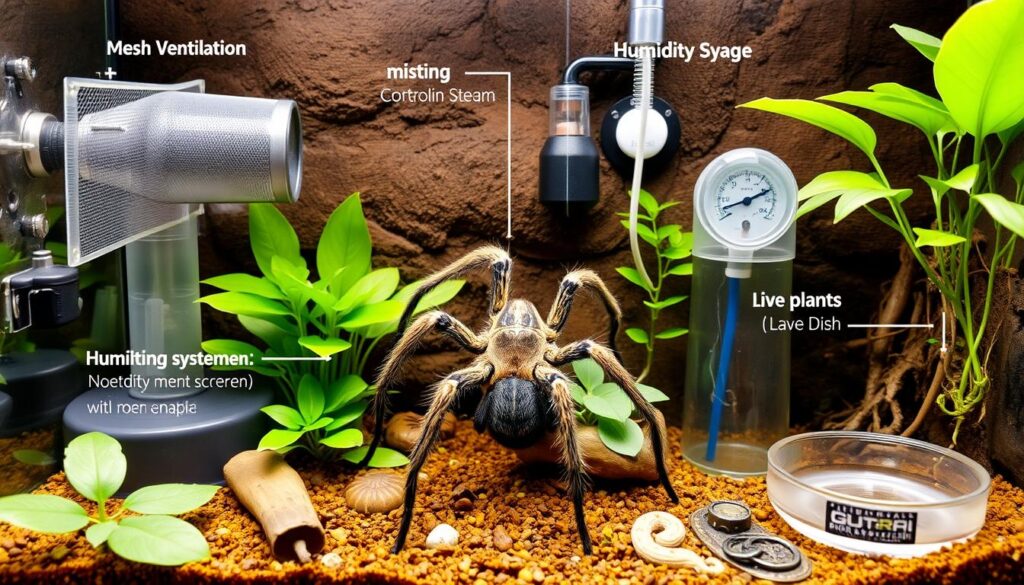
Lighting Adjustments for Optimal Environment
Proper tarantula habitat lighting is key for your tarantula’s health. Learning to adjust the terrarium’s light can help you create a natural environment. This is perfect for your tarantula.
To ensure the right lighting for tarantulas, follow these tips:
- Gradually adjust the terrarium lighting to mimic the natural day-night cycle of your tarantula’s home.
- Use a mix of UVA and UVB lighting to meet your tarantula’s specific needs.
- Change the lighting intensity and how long it’s on based on your tarantula’s species and preferences.
- Place the lighting right to offer the best basking and hiding spots in the terrarium.
- Watch how your tarantula acts and adjust the terrarium lighting as needed. This helps it stay active and healthy.
By carefully adjusting the terrarium lighting, you can make a space that’s close to your tarantula’s natural home. This supports its health and happiness.
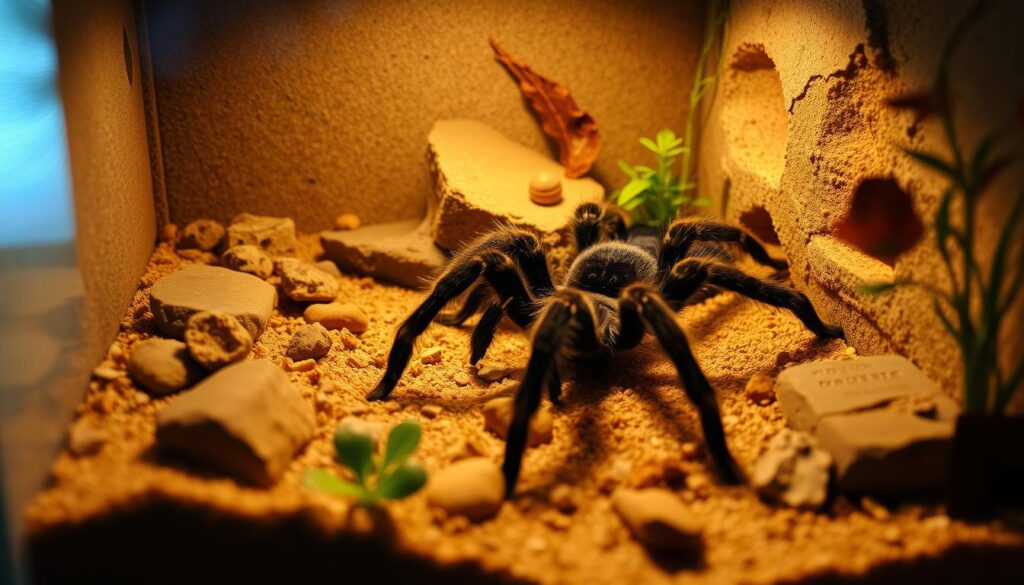
Pest Control Measures
Keeping your tarantula’s home pest-free is key to its health. Learning to spot common pests and how to safely get rid of them is crucial. This way, your tarantula’s home stays clean and safe, meeting its natural needs.
Identifying Common Pests
Some pests that might harm your tarantula include:
- Mites – Small arachnids that can multiply quickly and cause respiratory issues for your tarantula.
- Springtails – Tiny, jumping insects that feed on organic matter and can overpopulate the terrarium.
- Crickets – If left unchecked, these can become a nuisance and potentially harm your tarantula.
- Beetles – Various species of beetles may infiltrate the habitat and disrupt the delicate ecosystem.
Safe Pest Removal Techniques
To get rid of pests in your tarantula’s home, try these safe and effective methods:
- Use a vacuum cleaner to gently remove any visible pests and their egg sacs.
- Apply a non-toxic, natural pest control solution approved for use in tarantula enclosures.
- Introduce beneficial predatory insects, such as ladybugs or lacewings, to naturally control pest populations.
- Maintain excellent substrate hygiene and regularly replace the substrate to discourage pest infestations.
By using these tarantula habitat pest control steps, you can keep pests out. This ensures your tarantula’s home is a safe, healthy, and thriving place.
 Diseases and Treatments in Tarantulas: Common Pathologies and How to Act
Diseases and Treatments in Tarantulas: Common Pathologies and How to Act
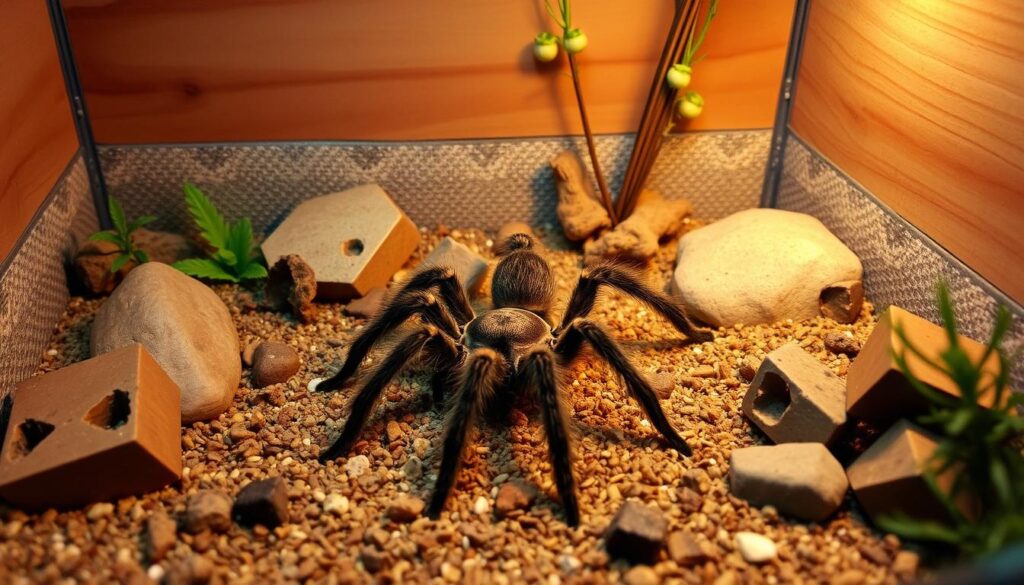
Recommended Cleaning Tools
Keeping a tarantula’s home clean is key to their health. You’ll need the right tools for the job. From rakes to disinfectants, the right gear makes cleaning easier and more effective. Let’s look at the best tools to keep your tarantula’s home in top shape.
- Substrate Rake: A long, sturdy rake is crucial for turning the substrate. It keeps humidity right and stops waste and bacteria buildup.
- Soft-Bristle Brush: A soft-bristle brush is perfect for cleaning the terrarium’s glass. It removes dust and debris without scratching.
- Terrarium Vacuum: A tarantula terrarium vacuum is a big help. It sucks up substrate, dirt, and small debris without bothering your tarantula.
- Disinfectant Spray: Use a safe disinfectant spray to clean and sanitize the terrarium. It keeps your tarantula’s home healthy and clean.
Always choose cleaning tools that are safe for your tarantula. Look for products made for reptile or invertebrate habitats. Always follow the instructions carefully.
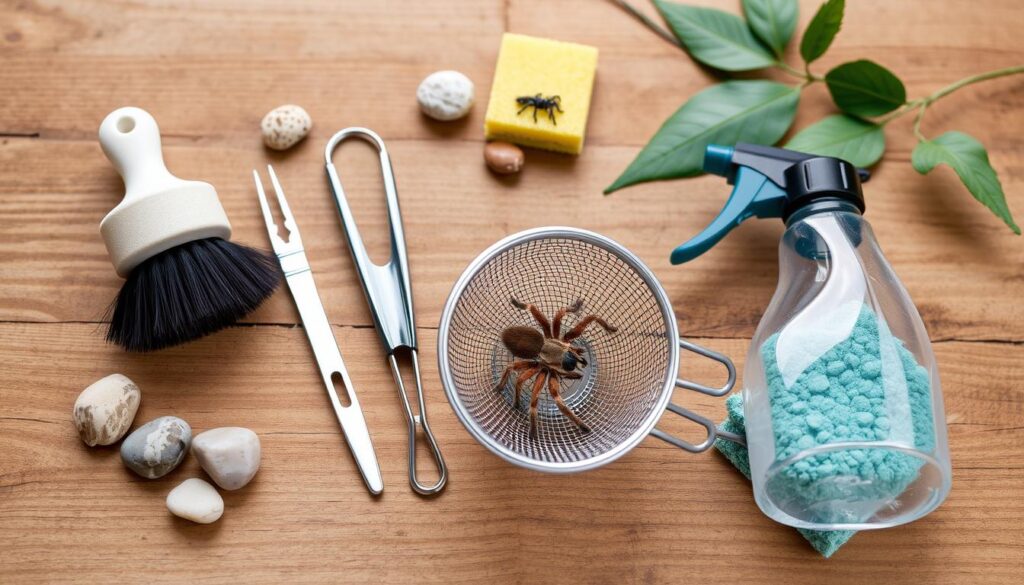
With the right cleaning tools, keeping your tarantula’s home clean is easier. You’ll provide a comfortable, thriving space for your arachnid friend.
Signs for a Deep Terrarium Clean
As tarantula owners, we must know when our pets’ homes need a deep clean. These signs help keep their environment safe and healthy.
Odor and Visible Buildup
Unpleasant smells mean it’s time for a deep clean. A foul or musty smell from the terrarium shows it’s dirty.
Also, look for visible debris like dried poop, uneaten food, and stuck substrate. This buildup harms your tarantula’s health and looks bad.
Watching for these indicators for deep cleaning tarantula terrarium and signs it’s time to thoroughly clean tarantula habitat helps. This way, you can stop problems like bacteria and breathing issues in your pet.
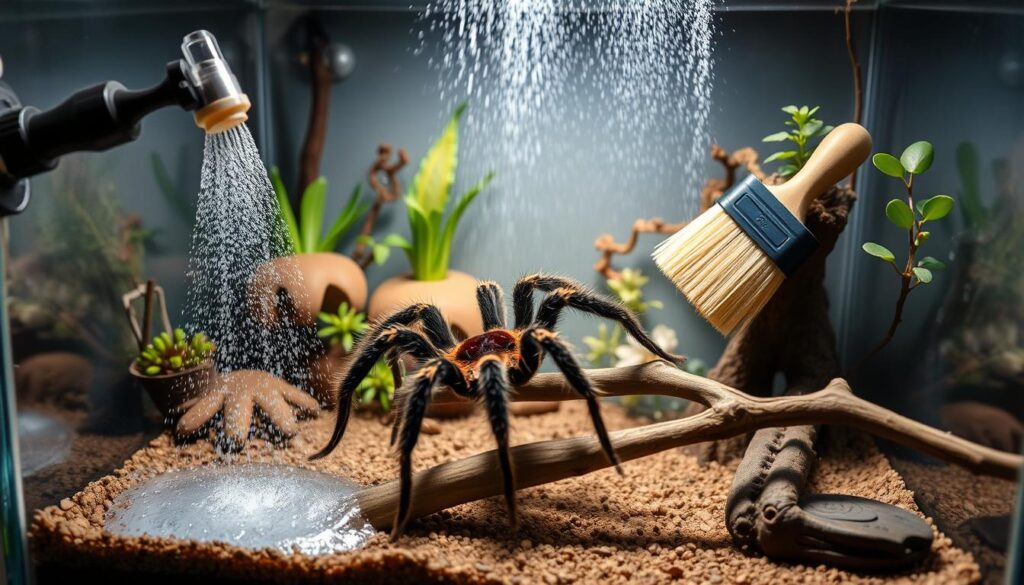
| Odor Indicators | Visible Buildup Indicators |
|---|---|
| Foul or musty smell | Dried fecal matter |
| Unpleasant odor | Uneaten food |
| Stale or stagnant air | Trapped substrate |
Tarantula Rehousing Process
Relocating your tarantula to a new terrarium is key to keeping it healthy. The steps for rehousing tarantulas need careful planning. This ensures a smooth transition for your pet.
Knowing how to transition tarantulas to a cleaned habitat is important. It makes the process safe for both you and your pet.
- Prepare the New Terrarium: Make sure the new habitat is clean. Use fresh substrate and install decor elements properly.
- Gather Necessary Supplies: Get all the tools you need. This includes a secure transport container, gloves, and a small paint brush or tongs.
- Carefully Transfer the Tarantula: Gently move the tarantula into the transport container. Be careful not to stress or hurt it.
- Place the Tarantula in the New Terrarium: Move the tarantula to its new home slowly. Let it explore its new surroundings.
- Monitor the Tarantula’s Adjustment: Watch how the tarantula adjusts. Make sure it’s comfortable in its relocated tarantula to new terrarium.
By following these steps for rehousing tarantulas, you can make the experience smooth for your pet. Proper preparation and a gentle approach are crucial for a successful relocating tarantula to new terrarium process.
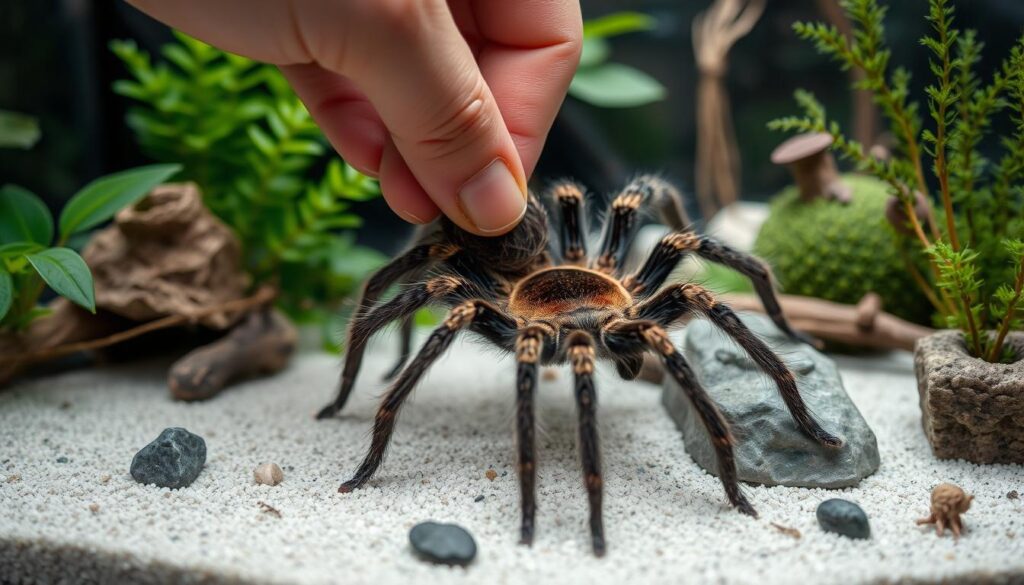
| Step | Description |
|---|---|
| Prepare the New Terrarium | Ensure the new habitat is thoroughly cleaned, with fresh substrate and properly installed decor elements. |
| Gather Necessary Supplies | Assemble all the tools you’ll need, including a secure transport container, gloves, and a small paint brush or tongs. |
| Carefully Transfer the Tarantula | Gently coax the tarantula into the transport container, taking care not to stress or injure it. |
| Place the Tarantula in the New Terrarium | Slowly and cautiously transfer the tarantula from the transport container to its new home, allowing it to explore its new surroundings. |
| Monitor the Tarantula’s Adjustment | Observe the tarantula’s behavior and ensure it is settling in comfortably in its new environment. |
Safety Precautions During Cleaning
Keeping your tarantula’s habitat clean is important, but your safety comes first. As you clean, follow safety tips for cleaning tarantula habitat to protect yourself and your pet.
Wear the right protective measures when maintaining tarantula enclosure. This means thick gloves, long-sleeved clothes, and eye protection. Tarantulas can surprise you, so it’s safer to be cautious to avoid bites or injuries.
Also, be careful with the products you use when cleaning tarantula terrarium. Stay away from harsh cleaners that could harm your tarantula. Choose natural, safe options instead. Make sure the area is well-ventilated and wash your hands well after cleaning.
 Dyskinetic Syndrome (DS) in Tarantulas: Causes, Symptoms, and Management
Dyskinetic Syndrome (DS) in Tarantulas: Causes, Symptoms, and Management

